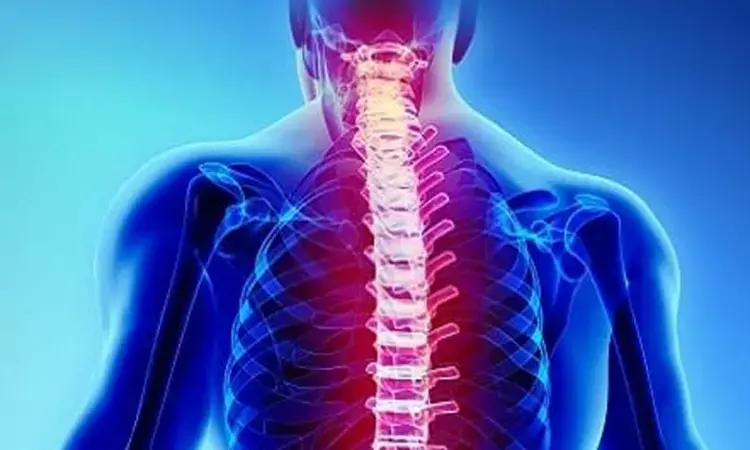- Home
- Medical news & Guidelines
- Anesthesiology
- Cardiology and CTVS
- Critical Care
- Dentistry
- Dermatology
- Diabetes and Endocrinology
- ENT
- Gastroenterology
- Medicine
- Nephrology
- Neurology
- Obstretics-Gynaecology
- Oncology
- Ophthalmology
- Orthopaedics
- Pediatrics-Neonatology
- Psychiatry
- Pulmonology
- Radiology
- Surgery
- Urology
- Laboratory Medicine
- Diet
- Nursing
- Paramedical
- Physiotherapy
- Health news
- Fact Check
- Bone Health Fact Check
- Brain Health Fact Check
- Cancer Related Fact Check
- Child Care Fact Check
- Dental and oral health fact check
- Diabetes and metabolic health fact check
- Diet and Nutrition Fact Check
- Eye and ENT Care Fact Check
- Fitness fact check
- Gut health fact check
- Heart health fact check
- Kidney health fact check
- Medical education fact check
- Men's health fact check
- Respiratory fact check
- Skin and hair care fact check
- Vaccine and Immunization fact check
- Women's health fact check
- AYUSH
- State News
- Andaman and Nicobar Islands
- Andhra Pradesh
- Arunachal Pradesh
- Assam
- Bihar
- Chandigarh
- Chattisgarh
- Dadra and Nagar Haveli
- Daman and Diu
- Delhi
- Goa
- Gujarat
- Haryana
- Himachal Pradesh
- Jammu & Kashmir
- Jharkhand
- Karnataka
- Kerala
- Ladakh
- Lakshadweep
- Madhya Pradesh
- Maharashtra
- Manipur
- Meghalaya
- Mizoram
- Nagaland
- Odisha
- Puducherry
- Punjab
- Rajasthan
- Sikkim
- Tamil Nadu
- Telangana
- Tripura
- Uttar Pradesh
- Uttrakhand
- West Bengal
- Medical Education
- Industry
Intraarticular structural bone grafting maintains column height in atlantoaxial facet joints

Intraarticular structural bone grafting in atlantoaxial facet joints has the advantage of maintaining anterior column height in the case of lateral mass collapse, reports a study recently published in the Journal of Orthopaedic Surgery and Research.
Jun Zhu and colleagues from the Division of Spine Surgery, Department of Orthopedics, Daping Hospital of Army Medical University, China investigated the necessity of nonstructural or structural intraarticular bone grafting in atlantoaxial facet joints via a posterior approach and the influence by the presence of basilar invagination (BI).
The authors reviewed patients who underwent posterior atlantoaxial or occipitocervical arthrodesis surgery at one institute. Operation records, preoperative and postoperative clinical status, and radiological films were analyzed.
Thirty-three patients (19 without BI, 14 with BI) underwent posterior facet joint release followed by intraarticular bone grafting were enrolled finally. Twenty-four nonstructural (15 without BI, 9 with BI) and 9 structural (4 without BI, 5 with BI) grafting were performed. The average follow-up was 32.15±6.73 months (24–47 months).
Among them, 1 (3.03%) implant failure occurred, and 32 (96.97%) achieved satisfactory neurological outcomes, including 28 (84.85%) complete and 4 (12.12%) acceptable reductions with complete fusion within 6 months.
For patients without basilar invagination, structural and nonstructural grafting showed no significant difference in terms of reduction maintenance (100% vs 73.33%, p = 0.530), while for those with basilar invagination, structural grafting significantly increased the postoperative height of the joint space (5.67±1.22 mm vs 3.43±1.78 mm, p = 0.002) and maintained it much better than nonstructural grafting (88.89% vs 20.00%, p = 0.023), contributing notably to basilar invagination correction.
Therefore, it was concluded that intraarticular structural bone grafting in atlantoaxial facet joints has the advantage of maintaining anterior column height in the case of lateral mass collapse or when basilar invagination correction is needed; otherwise, nonstructural bone grafting is enough.
Zhu, J., Wu, J., Luo, K. et al. Intraarticular bone grafting in atlantoaxial facet joints via a posterior approach: nonstructural or structural—a minimum 24-month follow-up. J Orthop Surg Res 16, 524 (2021). https://doi.org/10.1186/s13018-021-02630-z
Dr. Nandita Mohan is a practicing pediatric dentist with more than 5 years of clinical work experience. Along with this, she is equally interested in keeping herself up to date about the latest developments in the field of medicine and dentistry which is the driving force for her to be in association with Medical Dialogues. She also has her name attached with many publications; both national and international. She has pursued her BDS from Rajiv Gandhi University of Health Sciences, Bangalore and later went to enter her dream specialty (MDS) in the Department of Pedodontics and Preventive Dentistry from Pt. B.D. Sharma University of Health Sciences. Through all the years of experience, her core interest in learning something new has never stopped. She can be contacted at editorial@medicaldialogues.in. Contact no. 011-43720751
Dr Kamal Kant Kohli-MBBS, DTCD- a chest specialist with more than 30 years of practice and a flair for writing clinical articles, Dr Kamal Kant Kohli joined Medical Dialogues as a Chief Editor of Medical News. Besides writing articles, as an editor, he proofreads and verifies all the medical content published on Medical Dialogues including those coming from journals, studies,medical conferences,guidelines etc. Email: drkohli@medicaldialogues.in. Contact no. 011-43720751


